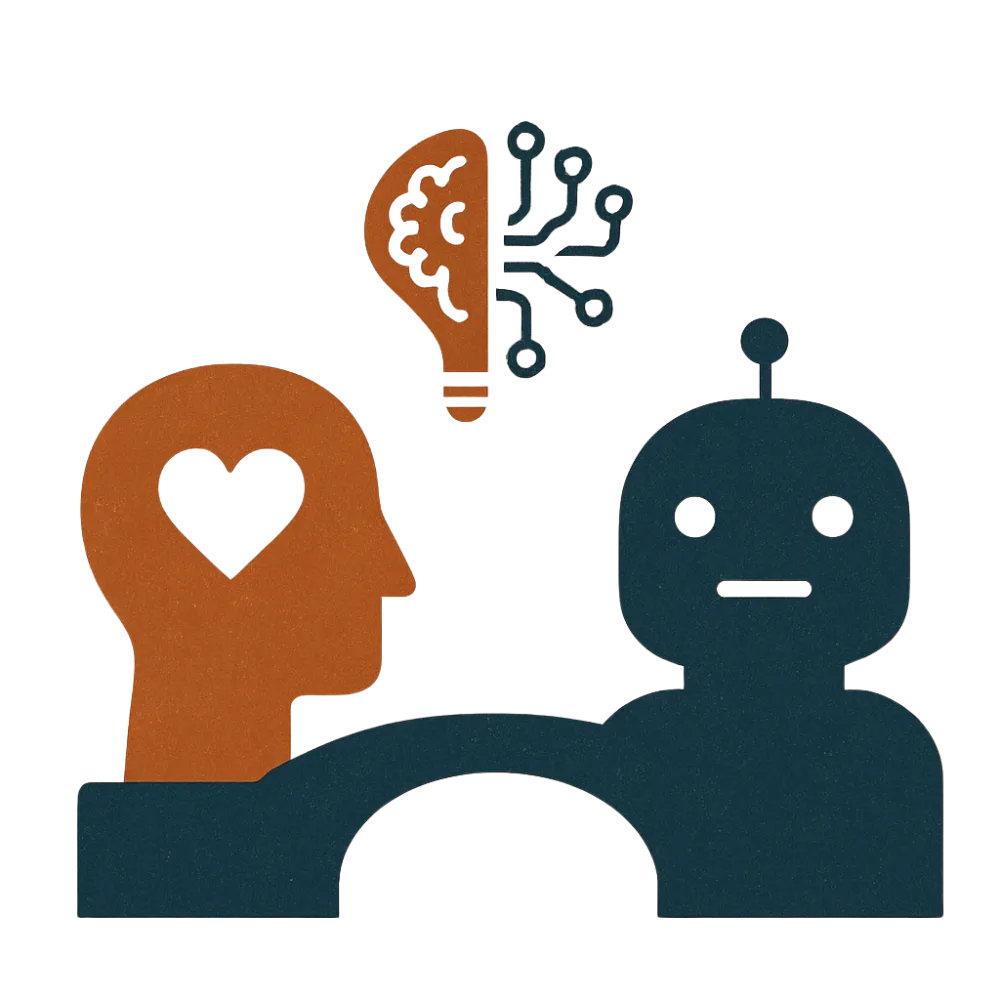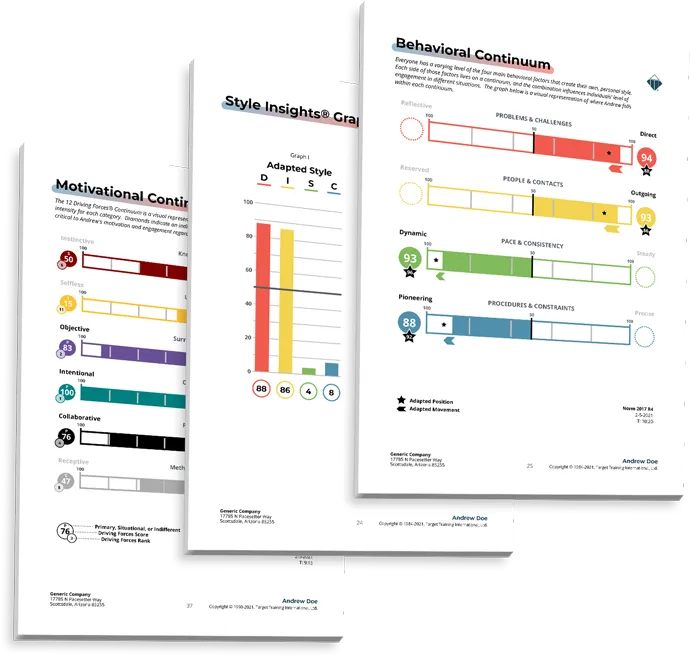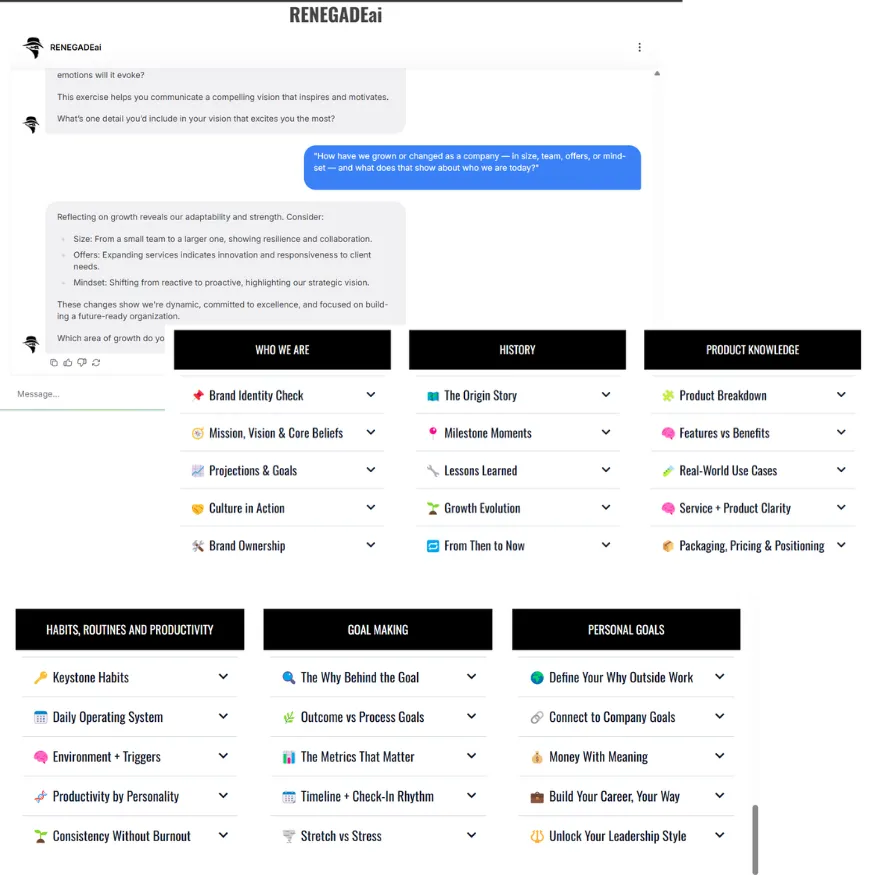Workforce RENEGADES
Powered By

Better Awareness. Better Decisions. Better Results.
Giving your AI the Awareness it needs to deliver the results you deserve.
We Fit You With the AI That's Right For You

Chat GPT
ChatGPT excels at natural, human-like conversation — making complex ideas simple, clear, and accesible.

Claude
Claude shines with thoughtful, ethical reasoning — prioritizing safety, context, and nuanced understanding.

Gemini
Gemini leads in multimodal capabilities — blending text, images, and data for rich, dynamic responses.

Grok
Grok stands out with its edgy, real-time updates — delivering fast, uncensored insights with personality
Features
Three Core Pillars of RENEGADEai

Talent Insight
The Foundation of your RENEGADai
We use your certified Talent Insights Report from TTI Success Insights®—which measures your unique DISC profile and Key Drivers—to shape how your AI thinks, decides, and leads.
This fuels everything your GPT says, how it solves problems, and the pace it moves.
What it gives you:
AI that mirrors how you communicate, behave, and make decisions
Behaviorally accurate responses rooted in your DISC style
Coaching and tasks aligned with what truly drives and motivates you
Brandvoice Engine
Your AI doesn't just work like you—it sounds like you.
Using your natural tone, energy, and motivators, we build a messaging layer that reflects how you communicate when you're at your best.
What it gives you:
Consistent, high-impact messaging that feels authentically you
Content suggestions, emails, scripts, and headlines aligned with your branding, messaging and behaviors.
Zero fluff. Zero filler. Just your tone—amplified.


Manager's Playbook
Turn your Talent Insights into tactical leadership.
We build a management engine inside your GPT using your natural strengths and leadership blind spots, pulled directly from your TTI report.
What it gives you:
Real-time prompts for handling conflict, delegating, or coaching
Custom communication strategies based on your personal communication and behavior style
Decision support that aligns with your high-drive motivators

Solutions
Bridging the Gap Between AI and Emotional Intelligence
Most AI is smart. Ours is aligned.
We develop custom AI engines for you and your business — based on how your people talk, lead, sell, and solve problems. We’ll help you catch up to where the world is heading without losing what makes your culture special.
What We Deliver
Tailor-made AI, trained on your voice, vision, and values
Tools your team actually wants to use
Fast implementation with hands-on support
Behavior-based training that blends human and machine
Immediate lift in clarity, communication, and consistency
AI That Fits Your Culture and Scales Productivity
We don’t drop in a generic bot and call it innovation. We dive into the DNA of your organization — your values, communication style, and team dynamics — then build custom AI that thinks, speaks, and coaches like your people. Tailored, intelligent, and aligned from day one.
Choose Your Assessment!
Leadership Assessment: Identify your leaders' natural communication, decision-making, and influence styles to ensure your AI coaches align with your leadership culture
Management Assessment: Map how your managers motivate, delegate, and lead teams so your AI reinforces effective management behaviors across your organization
Executive Assessment: Capture executive-level strategic thinking, adaptability, and pressure-tested leadership to train your AI with high-level decision-making intelligence
Sales Assessment: Unlock how your sales teams prospect, present, and close deals so your AI can coach to real-world selling strengths and overcome barriers
Engagement Assessment: Discover the personal drivers of engagement and motivation so your AI can fuel energy, loyalty, and peak performance in every interaction


Empower Culture and Communication with RENEGADEai
At its core, RENEGADEai isn’t just about boosting performance — it’s about transforming how your team connects, communicates, and grows together. By aligning your people with your purpose, RENEGADEai creates a stronger culture built on clarity, collaboration, and confidence.
Unifies team language — Everyone speaks the same values, expectations, and mission.
Strengthens collaboration — Builds real-time coaching and feedback loops between team members.
Fuels trust and transparency — Promotes open conversations that drive loyalty and performance.
Pricing
Choose a Plan That Suits Your Needs

RENEGADE Basic
$29/month
$297 Set Up Fee
-
One RENEGADEai Seat
Talent Insight Report
1500 Monthly Interaction
RENEGADE Community
RENEGADE Teams
$119/month
$1497 Set Up Fee
Everything in Basic plus...
Two RENEGADEai Seats
Six Talent Insight Reports
3500 Monthly Interacts
Branded Interface
Advanced analytics and reports
RENEGADE Corp
$199/month
$4997 Set Up Fee
Everything in Teams plus...
5 RENEGADEai Seats
15 Talent Insight Reports
7500 Monthly Interacts
Live 60 Minute Training Workshop
Four 30 Minute Clarity Consults
Set Up Fees Due to Start
Subscription Starts 30 Days After Set Up Complete
TESTIMONIALS
Hear What Our Clients Have to Say

"RENEGADEai completely changed the game for our team."
"The Basic RENEGADEai gave our reps instant coaching and confidence. We saw noticeable growth in lead generation, confidence and closing rates within just a few weeks!"
— Ashley M., Sales Director


"Our communication has never been stronger."
"Custom RENEGADEai connected our team like never before. It helped align conversations, sharpen collaboration, and eliminate misunderstandings across departments."
— Marcus T., Operations Manager


"RENEGADEai became the voice of our brand overnight."
"With Organizational RENEGADEai, we finally have an AI that sounds like us — living our values, speaking our language, and training our people exactly how we want."
— Jennifer L., Chief People Officer

Frequently Asked Questions
Your Questions, Answered Clearly
What is RENEGADEai?
RENEGADEai is a personalized AI coaching system that sharpens individual performance, enhances team communication, and aligns with your company’s voice, values, and goals.
How is Basic RENEGADE different from Custom or Organizational?
Basic RENEGADE builds a personal coach from your Talent Insight Assessment. Custom RENEGADE adds team connectivity and communication tools. Organizational RENEGADE embeds your full brand voice, culture, and product knowledge.
How do you build my personal AI coach?
We use your Talent Insight Assessment to program your coach’s style, communication, and learning approach — creating a coaching experience tailored to you.
Can RENEGADEai improve team communication?
Yes! With Custom and Organizational RENEGADE, your AI helps bridge gaps between team members, strengthen collaboration, and align everyone toward common goals.
Will RENEGADEai sound like our company?
Absolutely. Organizational RENEGADE is designed to capture your brand voice, core values, and unique product knowledge — making every interaction feel authentically "you."
Do we need technical experience to use RENEGADEai?
No tech skills needed! RENEGADEai is built to be user-friendly and easy to integrate into your daily workflow.
How fast can we launch RENEGADEai?
Basic RENEGADE can be live in just a few days. Custom and Organizational versions take a little longer, depending on the depth of customization.
What kind of ongoing support do we get?
Every RENEGADEai package comes with support to help you train, update, and evolve your AI as your team and goals grow.

Empowering businesses with innovative solutions, we are committed to providing seamless support and fostering growth. Connect with us for a brighter, smarter future!
Quick Links
Contact Us
Legal
© Workforce Renegades 2025 All Rights Reserved.
